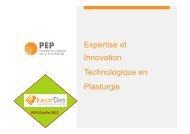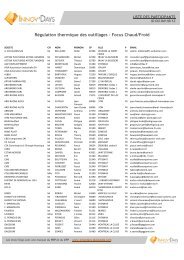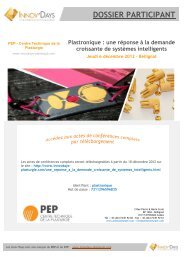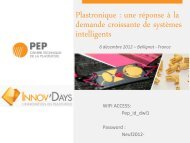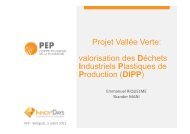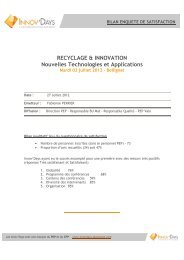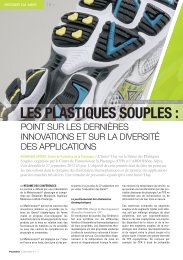Manufacturing of functional micro- and nanostructured plastic components
Nanostructured Surfaces - Innov'Days
Nanostructured Surfaces - Innov'Days
You also want an ePaper? Increase the reach of your titles
YUMPU automatically turns print PDFs into web optimized ePapers that Google loves.
<strong>Manufacturing</strong> <strong>of</strong> <strong>functional</strong> <strong>micro</strong>- <strong>and</strong> <strong>nanostructured</strong><br />
<strong>plastic</strong> <strong>components</strong><br />
CSEM<br />
N.Blondiaux, R.Pugin<br />
Bellignat, 08.12.2011
CSEM pr<strong>of</strong>ile<br />
Privately held Innovation Center, incorporated, not for pr<strong>of</strong>it<br />
since 1984, from watchmaking<br />
about 70 shareholders (mostly private)<br />
2010:<br />
close to 70 Mio. CHF annual turnover, c. 400 employees<br />
30 start‐ups created since 2000<br />
Activities:<br />
Applied research (contract with Swiss Government)<br />
Industrialization <strong>of</strong> technologies, product development<br />
Technologies:<br />
Micro‐ <strong>and</strong> Nanotechnology, Information Technology,<br />
<strong>and</strong> System Engineering<br />
Copyright 2011 CSEM | PEP | NBx | Page 1
CSEM pr<strong>of</strong>ile<br />
CSEM centres in Switzerl<strong>and</strong><br />
Thin films optics<br />
(27)<br />
(26)<br />
(21)<br />
Photonics<br />
(285)<br />
Microelectronics<br />
Microsystems technology<br />
Nanotechnology & Life Sciences<br />
System Engineering<br />
Time & Frequency<br />
Microrobotics<br />
Nanomedicine<br />
Copyright 2011 CSEM | PEP | NBx | Page 2
Nanotechnology <strong>and</strong> Life Sciences<br />
Technology Platforms <strong>and</strong> Applications<br />
Nanostructured Surfaces<br />
‐Systems for Life Sciences<br />
Copyright 2011 CSEM | PEP | NBx | Page 3
Nanotechnology <strong>and</strong> Life Sciences<br />
Nanostructured Surfaces<br />
• surface structures from 10 nm to 10 m<br />
• broad range <strong>of</strong> materials (incl SiX, metals)<br />
• inexpensive, scalable processes<br />
• tunable properties: chemical, optical, …<br />
• security features from r<strong>and</strong>om nanometric patterns<br />
• solar cells with light harvesting molecular layers<br />
• self cleaning surfaces<br />
• surfaces with enhanced specific area<br />
Copyright 2011 CSEM | PEP | NBx | Page 4
Nanotechnology <strong>and</strong> Life Sciences<br />
Strategy <strong>and</strong> Technology Bricks developed<br />
• Origination <strong>of</strong> surface/films nanostructures using molecular self-assembly (SA) <strong>and</strong> solgel<br />
processes<br />
• <strong>Manufacturing</strong> by combining SA with high throughput techniques (e.g. large area<br />
coating, <strong>micro</strong>-fabrication or replication techniques) : tooling & replication<br />
• Surface <strong>functional</strong>ization for added <strong>functional</strong>ities<br />
• Integration : the valorization <strong>of</strong> the technologies will depend on the capacity to integrate<br />
them into <strong>functional</strong> devices<br />
Self assembly<br />
Size: 40nm-200nm<br />
Copyright 2011 CSEM | PEP | NBx | Page 5
Nanotechnology <strong>and</strong> Life Sciences<br />
Strategy <strong>and</strong> Technology Bricks developed<br />
• Origination <strong>of</strong> surface/films nanostructures using molecular self-assembly (SA) <strong>and</strong> solgel<br />
processes<br />
• <strong>Manufacturing</strong> by combining SA with high throughput techniques (e.g. large area<br />
coating, <strong>micro</strong>-fabrication [etching] or replication techniques) → tooling & replication<br />
• Surface <strong>functional</strong>ization for added <strong>functional</strong>ities<br />
• Integration : the valorization <strong>of</strong> the technologies will depend on the capacity to integrate<br />
them into <strong>functional</strong> devices<br />
Copyright 2011 CSEM | PEP | NBx | Page 6
Nanotechnology <strong>and</strong> Life Sciences<br />
Strategy <strong>and</strong> Technology Bricks developed<br />
• Origination <strong>of</strong> surface/films nanostructures using molecular self-assembly (SA) <strong>and</strong> solgel<br />
processes<br />
• <strong>Manufacturing</strong> by combining SA with high throughput techniques (e.g. large area<br />
coating, <strong>micro</strong>-fabrication or replication techniques) : tooling & replication<br />
• Surface <strong>functional</strong>ization for added <strong>functional</strong>ities / enhanced properties<br />
• Integration : the valorization <strong>of</strong> the technologies will depend on the capacity to integrate<br />
them into <strong>functional</strong> devices<br />
Copyright 2011 CSEM | PEP | NBx | Page 7
Nanotechnology <strong>and</strong> Life Sciences<br />
Strategy <strong>and</strong> Technology Bricks developed<br />
• Origination <strong>of</strong> surface/films nanostructures using molecular self-assembly (SA) <strong>and</strong> solgel<br />
processes<br />
• <strong>Manufacturing</strong> by combining SA with high throughput techniques (e.g. large area<br />
coating, <strong>micro</strong>-fabrication or replication techniques) : tooling & replication<br />
• Surface <strong>functional</strong>ization for added <strong>functional</strong>ities<br />
• Integration : the valorization <strong>of</strong> the technologies will depend on the capacity to integrate<br />
them into <strong>functional</strong> devices<br />
PCR diagnostic device Biosensor Inserts for replication Filtration membranes<br />
Copyright 2011 CSEM | PEP | NBx | Page 8
Objective <strong>and</strong> Strategy<br />
• Objective:<br />
Develop processes <strong>and</strong> process chains for the low-cost fabrication <strong>of</strong><br />
<strong>micro</strong>-<strong>nanostructured</strong> <strong>components</strong>.<br />
• Strategy:<br />
Origination<br />
Tooling &<br />
replication<br />
Surface<br />
<strong>functional</strong>isation<br />
Integration<br />
Self assembly<br />
processes<br />
Top down<br />
processes<br />
Micr<strong>of</strong>abrication<br />
Electr<strong>of</strong>orming<br />
Hot embossing<br />
Injection molding<br />
MVD: molecular<br />
vapor deposition<br />
For molds <strong>and</strong> final<br />
parts<br />
Combination with<br />
other technologies<br />
(bio, electronics,<br />
robotics)<br />
Copyright 2011 CSEM | PEP | NBx | Page 9
Outline<br />
• Why <strong>nanostructured</strong> surfaces?<br />
• Self assembly<br />
• Polymer self assembly<br />
• Bead self-assembly<br />
• Fabrication <strong>of</strong> µ-<strong>nanostructured</strong> inserts<br />
• Mold-surface <strong>functional</strong>ization<br />
• Replication by hot embossing<br />
• Applications<br />
• Anti-counterfeiting<br />
• PCR diagnostic device<br />
• Conclusion<br />
Copyright 2011 CSEM | PEP | NBx | Page 10
Why <strong>nanostructured</strong> surfaces?<br />
Nanotopography<br />
Optical<br />
properties<br />
Adhesion &<br />
wettability<br />
Biological cell<br />
growth<br />
Specific<br />
surface-area<br />
CSEM’s DID<br />
• Anti-reflective properties<br />
• Structural colours<br />
• Plasmonic<br />
• Superhydrophobicity<br />
• Hemiwicking<br />
• Dry-adhesion<br />
• Cell adhesion<br />
• Cell migration<br />
• Cell differentiation<br />
• Enhanced properties<br />
• More sensitive<br />
sensors<br />
Copyright 2011 CSEM | PEP | NBx | Page 11
Self-assembly<br />
Bottom-up approach<br />
• Three bottom-up techniques:<br />
• Block copolymer self assembly<br />
• Polymer demixing<br />
• Bead self assembly<br />
• Fabrication <strong>of</strong> solutions / formulations <strong>and</strong><br />
deposition <strong>of</strong> the polymer/beads as thin films<br />
• The tunability <strong>of</strong> the process allows the fabrication <strong>of</strong> a wide range <strong>of</strong><br />
structures with lateral sizes from few tens <strong>of</strong> nm to tens <strong>of</strong> μm<br />
Copyright 2011 CSEM | PEP | NBx | Page 12
Self-assembly<br />
Fomulation<br />
Self assembly<br />
Polymer<br />
+ solvent<br />
Size: 40nm-200nm<br />
Dispersion<br />
Stabilisation<br />
Particles<br />
+ solvent<br />
+additives<br />
Steric stabilisation<br />
Size: 100nm-1µm<br />
Copyright 2011 CSEM | PEP | NBx | Page 13
Self-assembly<br />
Deposition<br />
• The polymer solution/bead suspension is then deposited on surfaces as a<br />
thin film<br />
Structured thin film<br />
Polymer blend solution<br />
Block copolymer solution<br />
Bead suspension<br />
- Spin coating<br />
- Dip coating<br />
- Slot die coating?<br />
Copyright 2011 CSEM | PEP | NBx | Page 14
Self-assembly<br />
Examples <strong>of</strong> <strong>micro</strong>-nanopatterns<br />
Block copolymer self assembly<br />
Bead self assembly<br />
Feature size: 30nm-200nm<br />
Feature size: 100nm-1000nm<br />
Polymer demixing<br />
Ref: Bead interference self assembly lithography<br />
2μm<br />
Feature size: 300nm-10µm<br />
Copyright 2011 CSEM | PEP | NBx | Page 15
Self-assembly<br />
Up-scale <strong>of</strong> the processes<br />
Copyright 2011 CSEM | PEP | NBx | Page 16
Self-assembly<br />
Repeatability<br />
Number <strong>of</strong> dots per µm 2<br />
Copyright 2011 CSEM | PEP | NBx | Page 17
Outline<br />
• Why <strong>nanostructured</strong> surfaces?<br />
• Self assembly<br />
• Polymer self assembly<br />
• Bead self-assembly<br />
• Fabrication <strong>of</strong> µ-<strong>nanostructured</strong> inserts<br />
• Mold-surface <strong>functional</strong>ization<br />
• Replication by hot embossing<br />
• Applications<br />
• Anti-counterfeiting<br />
• PCR diagnostic device<br />
• Conclusion<br />
Copyright 2011 CSEM | PEP | NBx | Page 18
Fabrication <strong>of</strong> µ-<strong>nanostructured</strong> inserts<br />
Combination with micr<strong>of</strong>abrication processes<br />
• Self assembled structures are used as etch<br />
masks<br />
• The structures are transferred into hard<br />
materials by RIE/DRIE<br />
• This combination allows the fabrication <strong>of</strong> high<br />
aspect ratio (up to 1:4) in various materials<br />
(polymers, silicon-based materials)<br />
• The dry etching procedure has been optimized<br />
to control the sidewalls <strong>of</strong> the structures<br />
transferred<br />
Copyright 2011 CSEM | PEP | NBx | Page 19
Fabrication <strong>of</strong> µ-<strong>nanostructured</strong> inserts<br />
Combination with micr<strong>of</strong>abrication processes<br />
Copyright 2011 CSEM | PEP | NBx | Page 20
Fabrication <strong>of</strong> µ-<strong>nanostructured</strong> inserts<br />
Fabrication <strong>of</strong> structured inserts<br />
• Integration <strong>of</strong> self assembly processes<br />
in CD/DVD stamper manufacturing<br />
chain<br />
• Fabrication <strong>of</strong> silicon master having<br />
patterns <strong>of</strong> <strong>micro</strong>-nanostructure<br />
• Electr<strong>of</strong>orming <strong>of</strong> nickel shims that can<br />
be integrated in replication tools<br />
• Fabrication <strong>of</strong> polymer «s<strong>of</strong>t shims» for<br />
hot embossing<br />
Copyright 2011 CSEM | PEP | NBx | Page 21
Outline<br />
• Why <strong>nanostructured</strong> surfaces?<br />
• Self assembly<br />
• Polymer self assembly<br />
• Bead self-assembly<br />
• Fabrication <strong>of</strong> µ-<strong>nanostructured</strong> inserts<br />
• Mold-surface <strong>functional</strong>ization<br />
• Replication by hot embossing<br />
• Applications<br />
• Anti-counterfeiting<br />
• PCR diagnostic device<br />
• Conclusion<br />
Copyright 2011 CSEM | PEP | NBx | Page 22
Mold‐surface <strong>functional</strong>ization<br />
How to solve demolding issues?<br />
• Parameters affecting demolding:<br />
• Structure-shapes (draft angle)<br />
• Surface chemistry (release coatings)<br />
• Problem:<br />
Due to the small size <strong>and</strong> high aspect-ratio <strong>of</strong> the structures, very thin<br />
(
Mold‐surface <strong>functional</strong>ization<br />
Mold-surface <strong>functional</strong>ization using MVD<br />
• MVD: Molecular vapor deposition<br />
• in‐situ deposition <strong>of</strong> (in)organic layers (SAMs)<br />
<strong>and</strong> multilayers (laminates) – self limiting process<br />
• low temperature process (35‐100°C)<br />
• coatings with anti‐stiction, hydrophobic, hydrophilic,<br />
biocompatible, protective, etc properties<br />
• MEMS, BioMEMS<br />
• <strong>micro</strong>‐fluidic devices, bio‐chips<br />
• optical sensors, pressure sensors<br />
• inkjet print heads<br />
Copyright 2011 CSEM | PEP | NBx | Page 24
Outline<br />
• Why <strong>nanostructured</strong> surfaces?<br />
• Self assembly<br />
• Polymer self assembly<br />
• Bead self-assembly<br />
• Fabrication <strong>of</strong> µ-<strong>nanostructured</strong> inserts<br />
• Mold-surface <strong>functional</strong>ization<br />
• Replication by hot embossing<br />
• Applications<br />
• Anti-counterfeiting<br />
• PCR diagnostic device<br />
• Conclusion<br />
Copyright 2011 CSEM | PEP | NBx | Page 25
Replication by hot embossing<br />
Fabrication <strong>of</strong> <strong>micro</strong>-<strong>nanostructured</strong> <strong>plastic</strong> parts<br />
• Preliminary results:<br />
Hot embossing in polycarbonate using <strong>micro</strong>-<strong>nanostructured</strong> s<strong>of</strong>t shims<br />
Copyright 2011 CSEM | PEP | NBx | Page 26
Outline<br />
• Why <strong>nanostructured</strong> surfaces?<br />
• Self assembly<br />
• Polymer self assembly<br />
• Bead self-assembly<br />
• Fabrication <strong>of</strong> µ-<strong>nanostructured</strong> inserts<br />
• Mold-surface <strong>functional</strong>ization<br />
• Replication by hot embossing<br />
• Applications<br />
• Anti-counterfeiting<br />
• Diagnostic PCR assay<br />
• Conclusion<br />
Copyright 2011 CSEM | PEP | NBx | Page 27
Application<br />
Anticounterfeiting<br />
• Concept: R<strong>and</strong>om <strong>micro</strong>- <strong>and</strong> nano-structures are fabricated <strong>and</strong> used as<br />
fingerprints for traceability <strong>and</strong> authentification<br />
Few cm<br />
few μm<br />
to<br />
few mm<br />
Human fingerprint<br />
Possibility to injection mold (PE)<br />
Copyright 2011 CSEM | PEP | NBx | Page 28
Application<br />
Anticounterfeiting<br />
• Integration:<br />
Characterization<br />
tools<br />
• Markets:<br />
Pharmaceutics ID documents Luxury goods<br />
Copyright 2011 CSEM | PEP | NBx | Page 29
Application<br />
PCR diagnostic device<br />
• Make PCR to determine the genome <strong>of</strong> the<br />
cell<br />
• Create patterns <strong>of</strong> cells (several cells per<br />
spot)<br />
• Fabricate a <strong>plastic</strong> <strong>micro</strong>scope slide with<br />
patterns <strong>of</strong> cell-repellent structures<br />
Structured: cell repellent<br />
Flat: cell adhesion<br />
Copyright 2011 CSEM | PEP | NBx | Page 30
Human osteosarcoma cells (SaOs-2) on Si pillars<br />
Flat 120nm<br />
200nm 500nm<br />
1m 2 m<br />
3m 4m<br />
Copyright 2011 CSEM | PEP | NBx | Page 31
Conclusion<br />
• Three different self assembly approaches, up-scaled (hundreds <strong>of</strong> cm 2 ), to<br />
create <strong>micro</strong> <strong>and</strong> nanopatterns<br />
• Combination with state <strong>of</strong> the art dry etching techniques to create high aspect<br />
ratio structures<br />
• Integration into CD/DVD stamper manufacturing chain to create replication<br />
tools<br />
• MVD technology used to make conformal release layers<br />
• Applications:<br />
• Anti-counterfeiting: fabrication <strong>of</strong> «nano»fingerprint for traceability <strong>and</strong><br />
authentication<br />
• Diagnostics: fabrication <strong>of</strong> a platform for PCR tests<br />
Copyright 2011 CSEM | PEP | NBx | Page 32
Acknowledgment<br />
• People:<br />
V. Monnier, G. Franc, I. Zhurminsky, B. Satilmis, M. Giazzon, M. Liley,<br />
H. Heinzelmann, R. Pugin<br />
• Funding: FP7 European project<br />
• Contact:<br />
Nicolas Blondiaux: nbx@csem.ch<br />
Raphaël Pugin: rpu@csem.ch<br />
Copyright 2011 CSEM | PEP | NBx | Page 33
Thank you for your attention!
Superhydrophic surfaces<br />
Superhydrophic surfaces<br />
• Lotus leaf • High aspect ratio Si pillars with chemical<br />
surface <strong>functional</strong>isation<br />
10 μm 2 μm<br />
Copyright 2011 CSEM | PEP | NBx | Page 35
Superhydrophic surfaces<br />
Investigation <strong>of</strong> rolling angles<br />
• High hysteresis<br />
Sticky drops<br />
2 μm<br />
• Low hysteresis<br />
Self-cleaning surfaces<br />
2 μm<br />
Jin et al., Advanced Materials 17 (2005).<br />
Copyright 2011 CSEM | PEP | NBx | Page 36
Superhydrophobic surfaces using silicon <strong>micro</strong>pillars<br />
• The wettability <strong>of</strong> the surfaces was also investigated<br />
using wet-mode ESEM.<br />
Problem:<br />
The electron-beam affects<br />
surface-chemistry <strong>and</strong> makes<br />
the surface hydrophilic<br />
Copyright 2011 CSEM | PEP | NBx | Page 37



